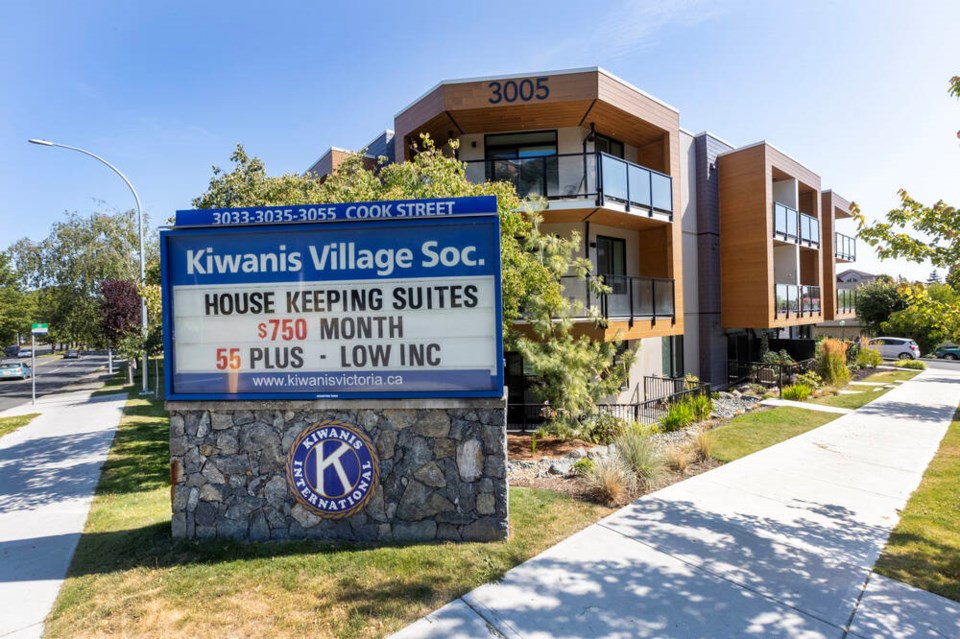Kiwanis project in Victoria shows affordable housing isn’t just a dream
July 28, 2025
By Gene Miller
Originally published in the Times Colonist

Honestly, what better place to start a housing affordability discussion than with the two-part headline in the June 24 Globe and Mail real estate section: “CMHC gives up on goal to reduce prices to 2004 levels” and “Home of the Week.”
The Home of the Week is a cozy five-bedroom job at 25 North Dr. in Toronto, which, friends tell me, is a large Canadian city east of Oak Bay. Don’t you just love the setting and the mood? Anyway, the place is yours for $14,995,000.
CMHC’s failed housing affordability goals and 25 North Dr. — flawless juxtaposition, yes?
If you connected all the Victoria housing affordability handwringing — from authorities, the media, the public, community interests and various advocacies — the bracelet of concern could ring the equator at least nine times. It wouldn’t produce another unit of affordable housing but never mind that.
Producing affordable housing locally often seems on a par with achieving world peace. Why is it so hard here?
Yes, we’ll talk numbers in a moment, but let’s start with this: If the community really wanted affordable housing, lots of it, as one of its highest priorities, there would be lots of affordable housing.
There’s no question that the numbers are a challenge to affordability, but their impacts can be blunted, and with some local projects (one profiled below), they have been.
It starts with the key players in housing delivery, where each declares it wants to produce affordable housing results, not excuses or disappointments. In other words, affordability is a product of almost personal social intention.
Anyone hoping to create affordable housing has to look not just at each cost item in the budget, but the reason behind it.
For example, change-resistant local culture has historically made the entire development-approval process pathologically slow. Lost time adds cost to development. Banks seem to want monthly interest payments from day one on their loaned millions.
In an effort to accelerate housing production, the province has now imposed automatic approval for multi-unit buildings up to six storeys, and redevelopment of single lots for four units. It sounds well-intentioned but may be more directed at housing supply than at affordability goals.
To sustain social trust in our institutions and policies, we need affordable-housing successes, not sort-of’s.
All of this, then, points to a “third way” — something to the side of government or the market.
Enter Kiwanis Village, around Cook and Finlayson. First, the Kiwanis motto: “Serving the children of the world.”
And among its objectives:
• To give primacy to the human and spiritual, rather than to the material values of life.
• To encourage the daily living of the Golden Rule in all human relationships.
• To promote the adoption and the application of higher social, business and professional standards.
I cite this to stress that the creation of affordable housing starts with moral intention and with a desire to make a social difference.
Kiwanis is a significant landowner, but by no means the only such. Many faith organizations, school districts, civic authorities and other institutions hold surplus land.
Kiwanis, with its housing-affordability intentions, was able to offer land at appraised value. It built a relationship with a skilled former market developer, who, instead of the normal profit role, took on the job as a fee-based project manager.
There are developers who are prepared to adopt this project-management role.
Further savings hide inside various government housing programs, fee waivers and project approval acceleration.
Kiwanis (“Our goal is to offer comfortable and affordable housing”) completed 78 units of new housing in 2024— studio, one- and two-bedroom and three fully accessible units for a per-unit cost of $265,000 (including land cost) — roughly half of conventional market costs.
The 2024 rent result? Studio $815 a month, one-bedroom $990/month, two-bedroom $1,240/month. These are roughly half of market rates. (There’s also a small common-area charge.)
Would it be too much to suggest that the provincial and municipal governments be all over this project, studying, to the last detail, how this was achieved … and then designing supportive policies and incentives?
Wouldn’t this also be an important process to study by every other entity that has land and wishes to embrace affordable-housing goals?
I think limitless credit goes to the Kiwanis developer and to any developer willing to bring expertise to the effort. So much rests on them, because it’s hard work achieving Kiwanis-like economies and outcomes.
But to anyone who says housing affordability cannot be achieved in the Victoria area, the Kiwanis result says, “Not true.”
Gene Miller is the founder of Open Space, founding publisher of Monday Magazine, originator of the Gaining Ground urban sustainability conferences, founder/developer of ASH houseplexes, and currently writing “Nothing To Do: Life in a Post-Work World.” He’d be pleased to receive and respond to your thoughts.
